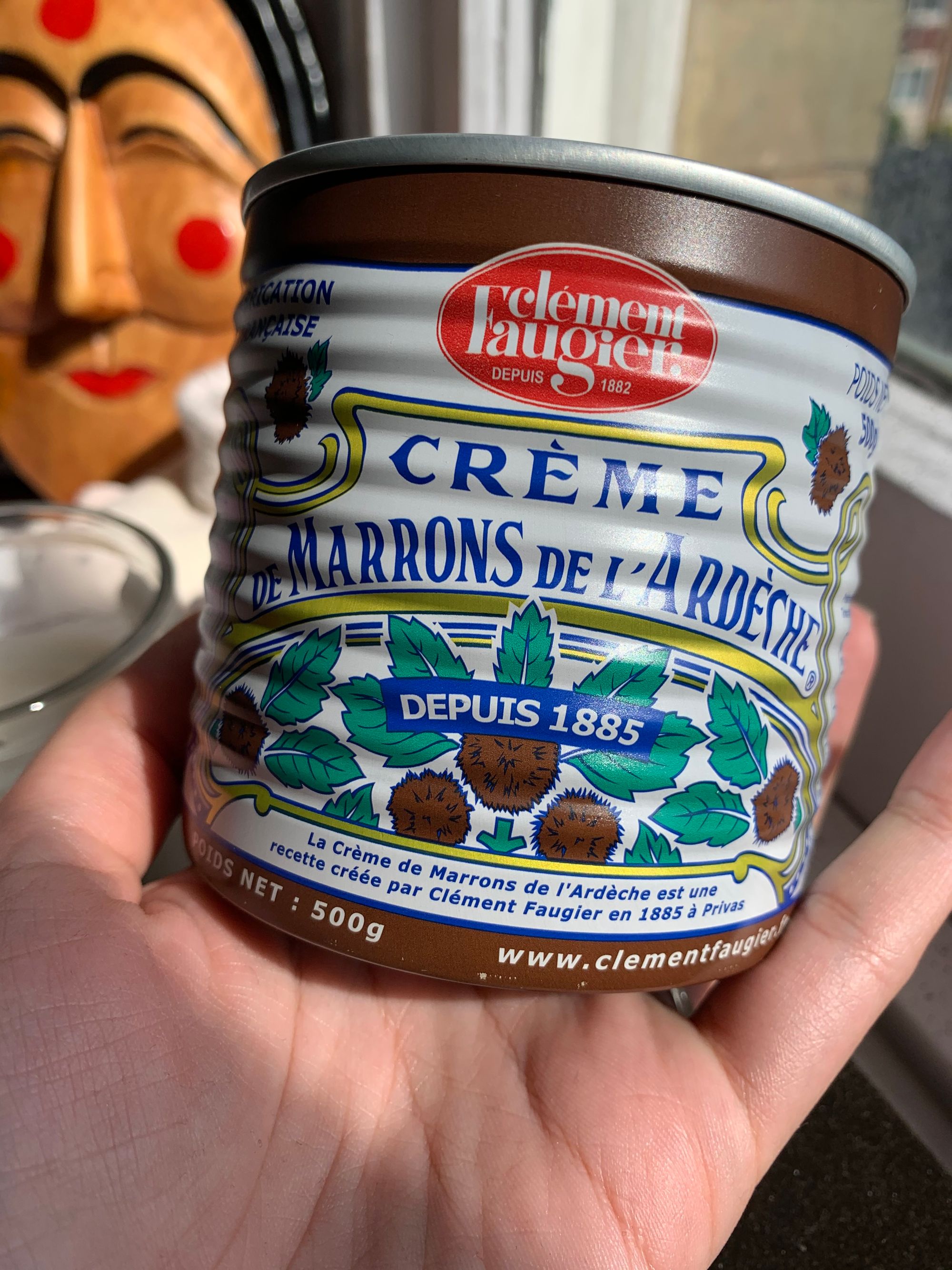Stone Soup #12: Chickpeas and Chestnuts - Chickpea Mont Blanc
Stone Soup is an ongoing quarantine feature in which I come up with a recipe that uses the impossible thing in your cupboard, without making you go to the store or wasting any of your ingredients. Last time, we used coconut flour to make waffle-batter funnel cake.
Do you ever think about how correct the song My Favorite Things from The Sound of Music is? I mean, shit. I also love bright copper kettles. Can’t relate to warm woolen mittens because I live in Los Angeles and wear tank tops in January, but brown paper packages tied up with string? Cream colored ponies? Raindrops on roses? Doorbells? Hell yeah. Bring it on. I can think of some other things to add to the list (turtles and cocktails and fat stupid pigeons) but overall, I agree with that song’s ideology and perspective.
Anyway. Let’s get to business. Chell says:
I’ve just heard of your stone soup project through some retweets and I adore it!
It reminded me that, after a trip to Paris, a friend gave me a beautiful tin of what I think is chestnut paste? She said it’s quite famous but I have absolutely no idea what to do with it, so it’s just been sitting in the cupboard for months now. I think my main problem is that I don’t even know what it tastes like, so I can’t work out if it should be sweet, savoury, or both! Chestnuts aren’t really something I’ve eaten very often so they’re quite mysterious to me.
My natural instinct is to try a cake. Alas, eggs are near-impossible to buy at the moment and flour similarly rare, although I do have a kilo of plain flour that I keep for feeding my sourdough starter, and a scant amount of self-raising. Other than that the baking cupboard is fairly well-stocked, and we have a range of dried pulses and some chicken. Aromatics and root veg are also in decent supply, and a large amount of kimchi, in case through some miracle kimchi and chestnuts make an unlikely pair.
Chell also included a photo of tin in question, which looks VERY French indeed:

That right there is a big ‘ol can of chestnut cream! There are only three major chestnut-producing regions left in France: Corsica, Ardeche (where these chestnuts hail from), and Limousin. Did you know: it’s only a limousine if it comes from the Limousin region of France, otherwise it’s just a sparkling van.
If you’re wondering if I only brought up the major chestnut-producing regions of France so that I could make that joke? Well. I’m very offended, and you’re absolutely right.
So, okay, these are from Ardeche. Otherwise, this is just like any other chestnut cream: a smooth, sweet spread made from chestnuts, sugar, and vanilla. That’s literally all the ingredients. Beautiful.
This stuff can be used anywhere you’d normally use nutella — spread it on toast, mix it into yogurt, use it to fill cookies, whatever — but Chell has a limited pantry and I think they deserve something special today. A really deluxe use for Creme de Marrons is in a dessert called a Mont Blanc, which has many variations but which must always include chestnut spread and whipped cream piled on top of meringues. Chell doesn’t have dairy for whipped cream, and also doesn’t any eggs to use to make a meringue… but according to their list of supplies, they do have the next best thing — dried pulses. So without further ado, let’s open up that cupboard and scale
Mont Chickpea
Okay so if you’re like me and had to look it up: the category of things that we call ‘pulses’ includes pretty much everything that you look at and think “ooh, a bean” before a pedant corrects you. That includes everything that is definitely a bean, plus dry peas, chickpeas, pigeon peas, lentils, something called ‘vetches,’ and a lot of other stuff. The thing I zoomed in on in that list (and then confirmed possession of with Chell) is the chickpeas, because I happen to know that chickpeas are magic. It’s going to take a little finagling, but we’re going to turn them into dessert.
Step one: Make some chickpeas. Follow the instructions in Act One of my Fuckton of Delicious Beans recipe, which can be summarized as: soak them overnight, then dump that water out and boil them for a few hours in loads and loads of water. That recipe advises putting flavor-items in the boiling liquid, like bay leaves and garlic and lemon peel. Don’t do that for this recipe, just leave the water plain. Don’t even add salt.
Once the chickpeas are fully cooked, drain them and save all the cooking liquid. This stuff is called aquafaba and it is as good as gold. You can use it as a thickening agent in stews and sauces, just freeze it in a jar and hang onto it — except for the half-cup we’re going to use for this recipe.
Do whatever you want with the chickpeas. You could freeze them for later, or eat them now. Might I recommend pan-frying them in oil with garlic, onion, dill, and lemon? Or maybe simmering them slowly in a hearty red sauce in the dutch oven, grating some cheese over the top of them, and letting that cheese get brown and bubbly under your broiler? While you decide what to do with your bounty, let that cooking liquid cool in the fridge until it’s nice and chilly.
Now, preheat your oven to 215°F. Do it immediately. Don’t forget! Also, line a couple of baking sheets with parchment paper or silpats.
Step two: Beat it. Get a big bowl. Make sure it’s very clean and very dry. Now combine half a cup of your reserved chickpea water with a quarter-teaspoon of cream of tartar. The cream of tartar is there because it’s an acid, and acids stabilize the structure of meringue; if you don’t have any, you can also use a little lemon juice or even a splash of vinegar.
If you have a hand mixer, use it for this recipe; otherwise, welcome to your new arm workout! Beat the aquafaba and cream of tartar together until they form soft peaks. It’ll take a while. Be patient. You should end up with a thick white foam that won’t quite hold a shape if you disturb it.
Step three: Welcome to sugartown, population: you. Measure out half a cup of sugar and beat it in very gradually, about a tablespoon at a time. Keep beating until the foam forms stiff, shiny peaks that hold their shape even if you tap the side of the bowl. Finally, add a splash of vanilla extract or a few dashes of bitters. Beat for one more minute. You should have a bowl of gorgeous, cloudlike white fluff.
Step four: Bag & pipe. Drop all your meringue into a piping bag (a gallon ziploc with one corner cut off will work great for this). Now, remember that parchment-lined pan? Just pipe dollops of meringue onto it, each one about 1.5” in diameter. Keep them 1” apart.
You’re going to wind up with a lot of meringues. Permit yourself to inhabit a space of abundance.
Step five: Bake. Put your meringues into the oven for 45 minutes, then swap your pans in the oven and rotate them 180 degrees to ensure even cooking. Wait another 45 minutes, then turn the oven off. 15 minutes after that, pull them out and let them cool. Whichever ones you don’t use right away will keep well in an airtight container in the fridge for, eh, a week or so.
Step six: That old chestnut. Okay, so the whole point of this was the Creme de Marrons, right? Let’s make good use of it. Scoop some of that chestnut cream into a bowl. Add a little honey or maple syrup to thin it a little — you want it thin enough to pipe, it shouldn’t take much. Just get the texture to a place where you feel happy with it, then put it into a piping bag. Again, a ziploc with the corner cut off is your friend.
Step seven: Make a mountain. We’re not a fancy French restaurant, so I’m not going to bother here with exacting, delicate plating. Make a little pile of meringues. Now pipe a mess of chestnut paste over the meringues — you can do a birds’-nest-looking-heap, or a tidy spiral, or a design that makes you feel fancy. Leave a snowcap of meringue peeking out of the top of the chestnut paste. If you have it, this is the part where you add whipped cream.
That’s it. That’s the dessert. You just made vegan meringue and topped it with chestnut paste, and now you’re enjoying one of the more deluxe French desserts that exists.
As I said before, there are a ton of variations on this recipe! You can add fruit, you can add whipped cream, you can perch this whole thing on top of a little cake. Some folks like to put frosting between the meringue and the chestnut paste. Grate some chocolate over the top of everything, or add a little powdered sugar to make it look snowy. The world’s your mountain; climb it as you see fit.
Just the recipe:
Mont Chickpea
- Cook some chickpeas with no flavoring in the water, not even salt. When the chickpeas are fully cooked, drain them, reserving the liquid. Cool the liquid fully and chill in the refrigerator. This liquid is called aquafaba.
- Combine .5C aquafaba with .25tsp cream of tartar. Beat to soft peaks.
- Add .5C white sugar, 1tbsp at a time. Beat to stiff peaks.
- Add a splash of vanilla extract or a few dashes of bitters. Beat 1 additional minute.
- Put into a piping bag and pipe 1.5” peaks 1” apart onto two or three parchment-covered baking sheets. Bake at 215°F for 90 minutes, swapping and rotating the baking sheets halfway through. After 90 minutes, turn off the oven but leave the pans inside. After 15 more minutes, remove from the oven and cool.
- Combine chestnut paste with honey or maple syrup until you’ve achieved a pipe-able consistency.
Pile up meringues and pipe chestnut paste on top until you feel satisfied. top with toppings if you want to: whipped cream, fruit, powdered sugar, nuts, whatever your heart desires.






Member discussion